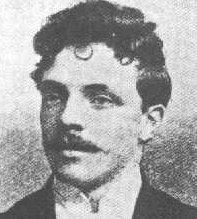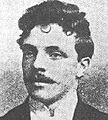Julio Herrera y Reissig facts for kids
Quick facts for kids
Julio Herrera y Reissig
|
|
|---|---|
 |
|
| Born | January 9, 1875 Montevideo, Uruguay |
| Died | March 18, 1910 (aged 35) Montevideo, Uruguay |
| Occupation | poet |
| Literary movement | Modernism |
Julio Herrera y Reissig (born January 9, 1875 – died March 18, 1910) was an important Uruguayan poet. He also wrote plays and essays. He started writing during a time called Romanticism and later became a key figure in a new style called Modernism.
Contents
Early Life and Family
Julio Herrera y Reissig was born in Montevideo, Uruguay. His family was wealthy and well-known in society and culture. His father was Dr. Manuel Herrera y Obes. His uncle, also named Dr. Julio Herrera y Obes, later became the president of Uruguay.
Health Challenges and Travel
Julio faced a big challenge: his health was not good. In 1892, when he was 17, he had a heart problem from birth. This problem got worse after he got typhoid fever. Because of his health, he had to stop his studies. He also could not travel far from home.
He mostly stayed in Montevideo. He did visit Buenos Aires once. He also spent time in the countryside of Uruguay, including a place called Castillo Piriá, near Piriápolis. A special plaque was put there in 1957 to remember his time living there.
His Special Writing Place
To pass the time, Julio loved to read many books. Around 1900, he started holding special meetings for writers at his family's large home. These meetings took place in the penthouse, which was called La Torre de los Panoramas. This name means "The Tower of Panoramas" because it had amazing views of the Río de la Plata.
It was in this tower that Julio's writing changed a lot. He moved from the older Romanticist style to a new, exciting style called Modernism. He even explored ideas similar to Surrealism. After he died, people realized how important his work was. He is now seen as a major poet in Latin American literature from the 20th century. Other famous poets from that time include Leopoldo Lugones and Ricardo Jaimes Freyre.
His Passing
Julio Herrera y Reissig died in Montevideo when he was 35 years old. This was a few years before his poems became widely known and praised by other writers. The Uruguayan writer Ángel Rama was very impressed by Julio's achievements. He said that in less than ten years, Julio created poetry that was subtle and modern, with perfect language.
What He Wrote
Julio Herrera y Reissig wrote many things, including stories and essays about politics. But he is most famous for his poetry.
Here are some of his well-known poetry collections:
- Canto a Lamartine (1898)
- Las pascuas del tiempo (1902)
- Los maitines de la noche (1902)
- La vida (1903)
- Los parques abandonados (1902–1908)
- Los éxtasis de la montaña (1904–1907)
- Sonetos vascos (1908)
- Las clepsidras (1909)
- La torre de las esfinges (1909)
- Los peregrinos de piedra (1909)
Images for kids
See also
 In Spanish: Julio Herrera y Reissig para niños
In Spanish: Julio Herrera y Reissig para niños 


